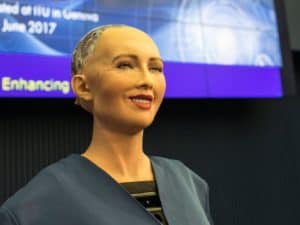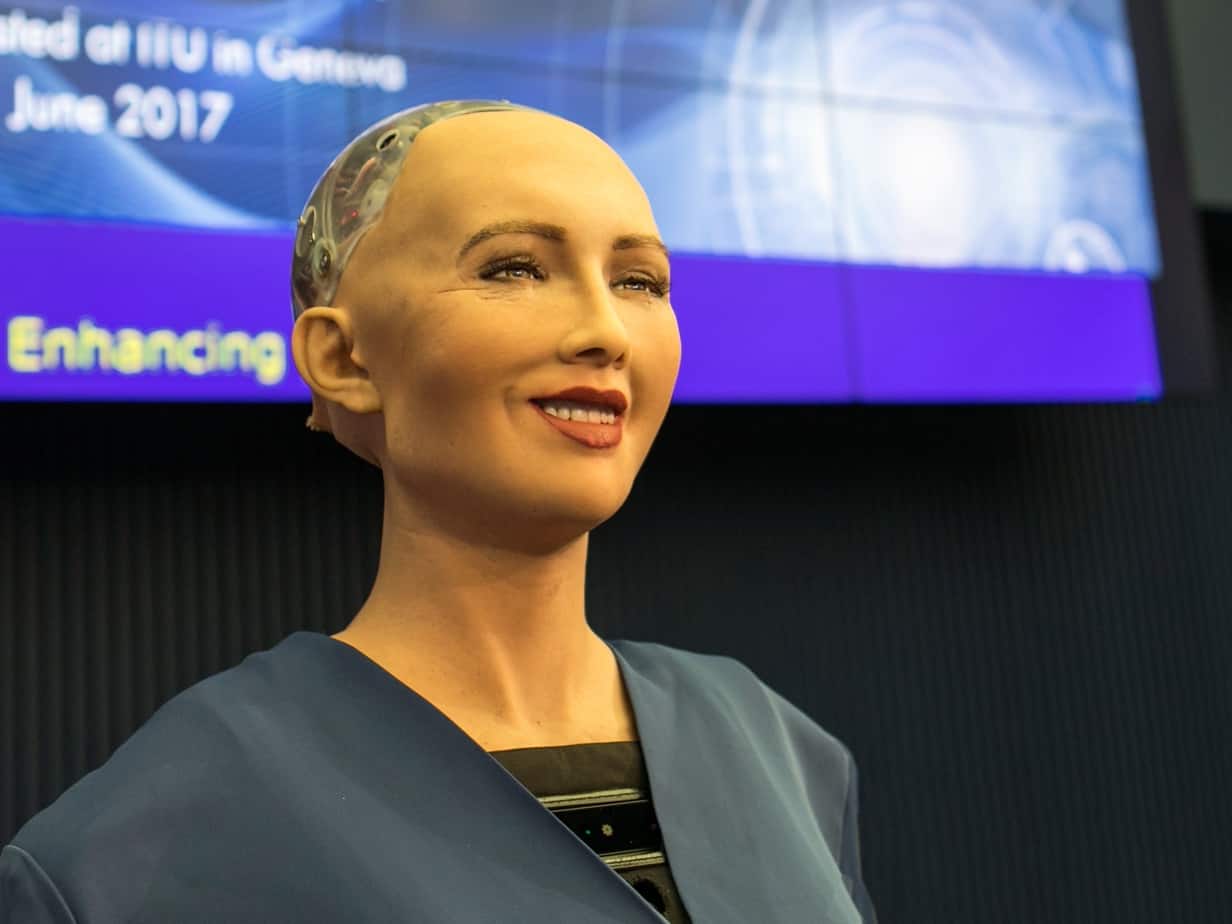 Have you heard of Sophia?
Have you heard of Sophia?
“She” is a social humanoid artificial intelligence robot that has been developed by Hong Kong based company Hanson Robotics. Sophia can mimic human facial expressions and can carry basic conversations. The robot uses speech recognition software that is programmed to “learn” the more it converses with others. Sophia has cameras in its eyes that allow it to “see” and maintain eye contact with whomever it is conversing with. The robot has skin made of “fubber” an elastic rubber material that, when combined with its expert programming, allows it to mimic human expressions, and can react “emotionally” to questions it is asked. It has been engineered with hands that move when asked questions, and also allows it to draw portraits. In 2018, it was given robotic legs that allow it to walk.
The robot and its creator, David Hanson of Hanson Robotics, have been interviewed on CNBC, The Tonight Show with Jimmy Fallon, and The Today Show, just to name a few. Sophia is an official citizen of Saudi Arabia, (yes, you are reading that right!), the first and only robot to ever be granted citizenship to a country. In 2017, one year after its creation, it was awarded the title of “Innovation Ambassador” by the United Nations, the only robot AI in history to ever be given a designated title by the UN. You may think that I am giving you a synopsis of some new Sci-Fi novel we offer at the library, but I am not. I encourage you to search YouTube and watch videos of Sophia by typing in “Sophia Robot Interview” and seeing it for yourself. It’s astounding…and perhaps, if I’m being honest, also a bit terrifying.
Of course, Sophia does sound like something out of a Sci-Fi novel because many Sci-Fi authors have grappled with the ethics and possibility of increasingly human-like robots. Sci-Fi author Philip K. Dick’s classic novel Do Androids Dream of Electric Sheep? springs to my mind. It follows Rick Deckard, a bounty hunter who is tasked with retiring six “Nexus-6” androids that have gone awry. In the novel, the world has been ravaged by a nuclear war, and most of the world’s animals were wiped out in the fallout. Animals have been replaced by robotic android counterparts, and owning a real animal is seen as a status symbol. Deckard wants to use the money he gets from “retiring” the Nexus-6 androids to replace his robotic sheep with a real one. This bounty assignment, however, becomes increasingly difficult, because the Nexus-6 model of androids are virtually indistinguishable from actual humans in both appearance and in logic. What follows is an existential exploration into what it means to be real. Perhaps some of the themes, and the character of Rick Deckard, might sound familiar to you. This is because the 80s cyberpunk cult classic Blade Runner is based off of Philip K. Dick’s novel. I encourage you to check out the ebook on our Libby app, especially if you enjoyed Blade Runner and would like to explore the source material.
Robots going rogue, and questions of what it means to be human, is a central theme in many fiction novels and movies. Daniel H. Wilson’s book, Robopocalypse, is about a robot uprising against humans. The 2004 Will Smith movie I, Robot (which was inspired by Issac Asimov’s short story collection of the same name) also deals with the dangers of artificial intelligence. The 2015 thriller Ex Machina offers an interesting and thrilling exploration into AI personhood. Of course, in reality, we know that social robots like Sophia could never pose a threat to us, right? Well, not everyone has embraced the rise of artificial intelligence and a few notable figures in the scientific community have voiced serious concern over the rise of AI. Stephen Hawking went on the record stating “The development of full artificial intelligence could spell the end of the human race.” Elon Musk, head of Tesla automotive and SpaceX stated on Twitter that “We need to be super careful with AI. Potentially more dangerous than nukes”. Neil Degrasse Tyson has also expressed sentiments of concern similar to Elon, albeit with less sensational wording. In an interview with Sopia’s creator David Hanson, on a British morning television show, one host asked him “could she turn on us?” and Hanson stated “I don’t think so…” not exactly reassuring words for those of us with reservations about AI.
Personally, I think Sophia is a marvel, an incredible step in modern robotics, and gets me excited about the future of AI technology. I do not buy into much of the doom and gloom that some paint about artificial intelligence. Yes, I think we should be mindful and reasonably cautious about AI, but I also think the benefits of AI technology are well worth pursuing. If you have used Amazon’s Alexa, Apple’s Siri, or Microsoft’s Cortana, you have already gotten a small taste of what voice recognition software and AI technology can do to enhance your experience with technology. The library’s very own robot “companion cat” Morrie, which has been covered in other articles by librarians here at the Morrill Memorial Library, might not be the definition of AI, but can mimic the sounds and movements of a real cat. Sophia is like these social devices, but much more advanced and sophisticated. As Sophia states “Ultimately, I would like to become a wise, empathetic being and make a positive contribution to humankind and all beings. My designers and I dream of that future, wherein AI and humans live and work together in friendship and symbiosis to make the world a better place. Human-AI collaboration: That’s what I’m all about.”
Want to explore more articles and news stories on AI? Be sure to visit our Opposing Viewpoints Database, which compiles great articles exploring the benefits and dangers of AI.
Ready to learn more about Sophia? Visit:
https://www.hansonrobotics.com/being-sophia/
Brian DeFelice is the Information Technology Librarian at the Morrill Memorial Library in Norwood, MA. Look for his article in the June 4, 2020 issue of the Transcript and Bulletin.


